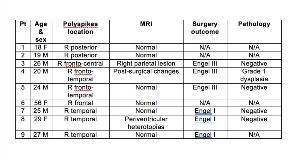What Do Focal Polyspikes Mean?
Abstract number :
1.133
Submission category :
3. Neurophysiology / 3A. Video EEG Epilepsy-Monitoring
Year :
2018
Submission ID :
494771
Source :
www.aesnet.org
Presentation date :
12/1/2018 6:00:00 PM
Published date :
Nov 5, 2018, 18:00 PM
Authors :
Selim Benbadis, University of South Florida; Angelica Rivera-Cruz, University of South Florida; Stephanie MacIver, University of South Florida; and Fernando Vale, University of South Florida
Rationale: Polyspikes are usually generalized and are associated with idiopathic (genetic) generalized epilepsies. Focal polyspikes have been shown to be associated with focal cortical dysplasias, and are usually seen extra-temporal or neocortical epilepsies. The purpose of this study was to describe a series of patients with focal polyspikes evaluated at our epilepsy center. Methods: We reviewed our EEG-video monitoring database between October 2013 and April 2018, to identify patients with focal polyspikes. All patients were evaluated with EEG-video monitoring. AllEEG-video studies were interpreted by Board-certified EEGers. Results: Nine patients were identified. Out of 1,513 patients monitored during the same period, this represents 0.16% of studies. Ages ranged from 18 to 56 years (mean 27). The mean age of seizure onset was 15 years (range 7-21). There were 6 male and 3 females. All had epilepsy, and 6 were medically intractable and were evaluated for surgery. Six patients had normal imaging. Six patients underwent epilepsy surgery. Three of them continue to have intractable seizures. Five had negative pathology, and one had confirmed cortical dysplasia. None of the patient had typical mesiotemporal sclerosis (MTS). Conclusions: Focal polyspikes are uncommon compared to other types of focal epileptiform discharges, but are encountered at surgical centers. They are not seen in MTS. Our series was hampered by limited specialized neuropathology. When available, pathology revealed cortical dysplasias. Funding: No funding
